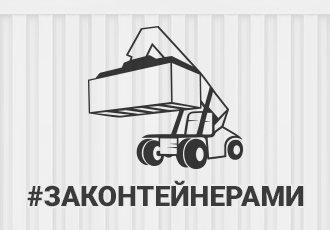Container Logistics in Russia and Neighbouring States
Исследования | Сентябрь 07, 2008, 23:26
The political quandary and resulting military hostilities that befell Russia in August 2008 – coupled with the global economic crisis and the international impact the Russian-Georgian conflict has yielded – have made for the major reason why the present report appears at a later time than anticipated.
As has happened before, troubles have transcended the boundaries of the container industry alone and are no longer limited to purely economic implications. Until very recently, one was still entertaining the hope that the world economic recession would skim Russia, leaving no painful consequences: What crisis? Oh yeah, that crisis!
Still, fuelled by political agendas, the situation seems to be developing in the right direction – namely, toward a complete regeneration of the economy.
What will this process involve? And why do we believe so, in the first place? Les us be reminded that a decade ago, the ruins left by another economic cataclysm – the 1998 Default – gave rise to many Russian industries, the container and logistics sectors included. But all of the industries that have experienced a dramatic surge in the past ten years are beset by humongous costs: In Russia, everything today is not just expensive, but the most expensive. Turning the tides here will no longer be possible with administrative steps alone. No ordinary measures to trigger an internal economic crisis will suffice, either – not with such gold and foreign-exchange reserves, anyway. A genuine disruption was in order. Georgia obliged with such an opportunity, and Russia used the newly created imbroglio in full, taking a headlong plunge into it.
What should we expect as a result one or two years down the road? A revived economy – one with lower costs – is the desired outcome. Keeping those costs in check is the foremost priority. The impending crisis or recession, combined with an absence of fund injections from the West, should help. Salaries, bonuses, percentages, kickbacks, bribes – all of this is bound to change.
Our task is to show how transport costs can be cut along the whole logistical chain. How to help spur the growth of offer in logistics services so that it would outpace the demand. If these goals are met, the crisis will prove to be a blessing in disguise.
“Container logistics in Russia and neighbouring states in January to June 2008” (107 pages) English – 60 th. rur or $2,500.
To order a copy of this report please contact us at: Tel.+7 (495) 940-90-61 E-mail: info@infranews.ru
Introduction 3 1. THE WORLD CONTAINER TRANSPORT MARKET 5 1.1. Shipping companies 5 2. FREIGHT RATES 10 2.1. Russia’s Northwest 10 2.3. Russia’s South 11 2.4. The Russian Far East 15 3. TERMINALS AND LOGISTICS OF THE RUSSIAN NORTHWEST 18 3.1. The Gulf of Finland’s Neva Bay 18 3.2. First Container Terminal 23 3.3. Petrolesport 26 3.4. The Big Kaliningrad area 29 4. RUSSIAN CONTAINER TERMINAL MARKET: OVERALL STATISTICS 31 5. THE RUSSIAN FAR EAST 34 Vostochnaya Stevedore 34 Vladivostok Container Terminal (VCT) 39 Other terminals of the Russian Far East 45 6. RUSSIA’S SOUTH 46 Novorossiysk 46 7. THE FORMER SOVIET STATES ON THE BALTIC 52 Tallinn 52 Klaipeda 54 Riga 54 8. FINLAND 57 9. UKRAINIAN TERMINALS AND CONTAINER LOGISTICS 61 HPC Ukraine (Odessa) 61 Ukrtranscontainer’s Ilyichevsk 66 10. REGIONAL DISTRIBUTION OF RUSSIA’S CONTAINER TRAFFIC 70 11. HOLDINGS OF THE RUSSIAN CONTAINER BUSINESS 75 Stevedoring holdings 75 Logistics holdings 80 12. CONTAINER TRANSPORTS BY RIVER 81 Trade history and development 81 Starting a regional river-based container business: Notes on a sample case 85 Sample case study: Samara region and its cargo flows 86 Conclusions 92
Новости по теме
-
Рынок перевозок в танк-контейнерах по итогам первого квартала 2024 года
Исследование танк-контейнерного рынка России по итогам первого квартала 2024 года
-
Контейнерный отчет по итогам I квартала 2024 года
Всё о рынке контейнерных перевозок по итогам первого квартала 2024 года. Мировой рынок, железнодорожные перевозки, морской фронт.
-
Расходы на оперирование судном: структура, динамика, тенденции, прогнозы
Исследовательское агентство InfraNews завершило работу над отчетом по структуре и динамике расходов на оперирование судном
Свежие новости
-
Американский регулятор обязал железнодорожные компании США пускать на свои сети конкурентов
Регулятор индустрии грузовых железнодорожных перевозок в США вводит правило, согласно которому при определенных условиях частные железнодорожные компании будут обязаны пускать на свои сети конкурентов
-
К апрелю 2026 года MSC увеличит отрыв от ближайшего конкурента до 1,5 крат
Через 2 года вместимость флота крупнейшего в мире контейнерного оператора MSC будет превышать 7 млн TEU, в полтора раза больше, чем у CMA CGM, которая выйдет на второе место
-
Флот «Евросиба» пополнился контейнеровозом EUROSIB 1 вместимостью 1258 TEU
Флот компании «Евросиб» пополнился контейнеровозом EUROSIB 1 вместимостью 1258 TEU
-
Финпоказатели Maersk несколько улучшились, но линейный бизнес остается убыточным
Группа Maersk по итогам первых трех месяцев 2024 года получила 177 млн долларов операционной прибыли по сравнению с более чем полумиллиардным убытком в предыдущем квартале
-
За два года FESCO перевезла на линии между Новороссийском и Турцией более 40 тыс. TEU
Транспортная группа FESCO за первые два года работы регулярной контейнерной линии FESCO Turkey Black Sea перевезла между Новороссийском и турецкими портами Гебзе и Стамбул более 40 тыс. TEU







